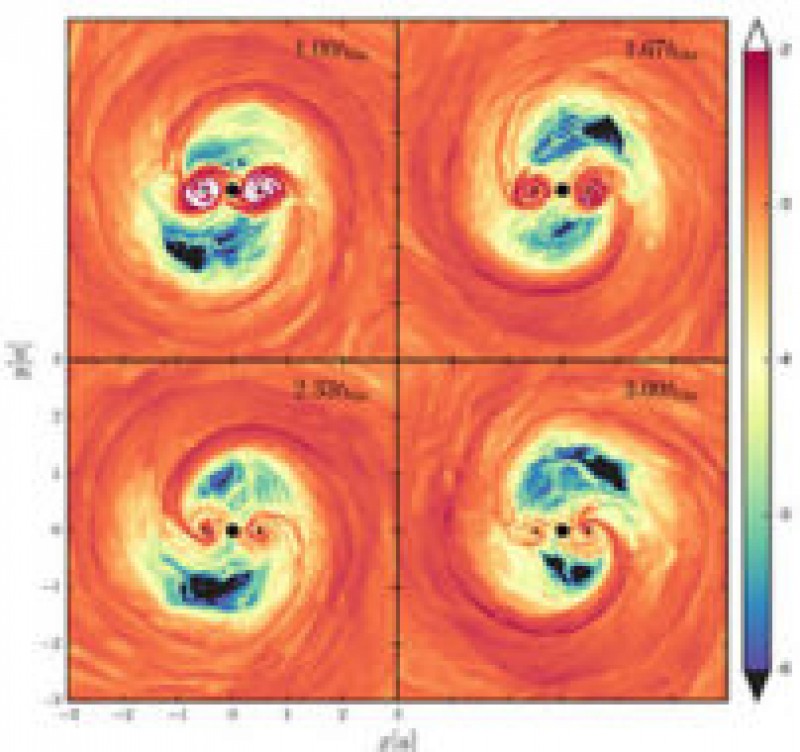Merging Supermassive Black Holes Produce Light Signals

These panels follow two supermassive black holes at the center of a large gas disk that are on a collision course. (Time stamps in the upper right corner of each snapshot, sequence begins top left.)
RIT Center for Computational Relativity and Gravitation
New high-powered simulations by Dennis Bowen (Rochester Institute of Technology) and colleagues confirm that two gargantuan black holes feed in an on-again-off-again pattern as they spiral in toward each other. Previous work showed that, when a binary supermassive black hole forms, each black hole should have its own small disk of accreting gas, fed by a larger disk that encircles the pair. A lump forms within the larger disk and links up first with one gas stream, then the other, alternately dumping gas into each mini-disk.
Previous simulations had seen this effect, but the new work, published in the January 20th Astrophysical Journal Letters, found that when the black holes are closer together the swing in the balance of mass between the two mini-disks is even more dramatic. The interaction of the disks should create periodic light signals. Such signals are potentially similar to those seen when a supermassive black hole shreds a star.
The team is currently putting together more precise predictions for what astronomers might see from merging binaries. Read more in RIT’s press release.
Camille M. Carlisle
Below: the team's simulation of two supermassive black holes caught in a binary. An alternating flow of gas fills and depletes the mini-disks feeding the black holes (The black dot at the center of the image is a region cut out of the simulation, to make the calculations easier.)
Most Distant Superluminous Supernova
Astronomers have detected the most distant supernova, flashing at us from more than 10 billion years in the past. Mathew Smith (University of Southampton, UK) and an international team of colleagues found the exploding star as part of the Dark Energy Survey Supernova Program.
The event, called DES16C2nm, has a redshift of 1.998 and appears to be poor in hydrogen, as many of its rare, bright class of superluminous supernovae are. Why they're so bright remains unknown, but they look similar to the explosive deaths of massive stars that have lost their outer hydrogen envelope.
When combined with 10 other superluminous events, DES16C2nm turns out to be part of a fairly uniform group, with similar peak brightnesses at ultraviolet wavelengths. There’s no sign that the supernovae’s properties differ across cosmic time, which could help astronomers understand what creates them.
The team expects that DES will be able to detect such supernovae from the last 12 billion years; upcoming facilities may push even farther back in time. The team’s paper appears in the February 10th Astrophysical Journal. You can also read more in the Southampton press release.
Camille M. Carlisle
University of Central Florida to Take On Arecibo Observatory

305-meter dish at the Arecibo Observatory, the world's largest radio telescope .
NAIC
Beginning on February 22nd, the University of Central Florida (UCF) will start to take over the operation and management of the Arecibo Observatory in Puerto Rico from the National Science Foundation (NSF).
Arecibo has long been threatened by funding shortfalls, and in the fall NSF announced plansto reduce its funding of Arecibo from its current $8 million per year to $2 million per year in 2022, while simultaneously seeking alternative sources of funding. Now, UCF will be providing support and technical personnel to manage the observatory, its research — including NASA's near-Earth asteroid observations — and associated educational activities. UCF astronomers will receive some dedicated time on the radio dish, and observing time will also still be awarded to the larger astronomical community. Read more in NSF’s press release.
Source: Monica Young